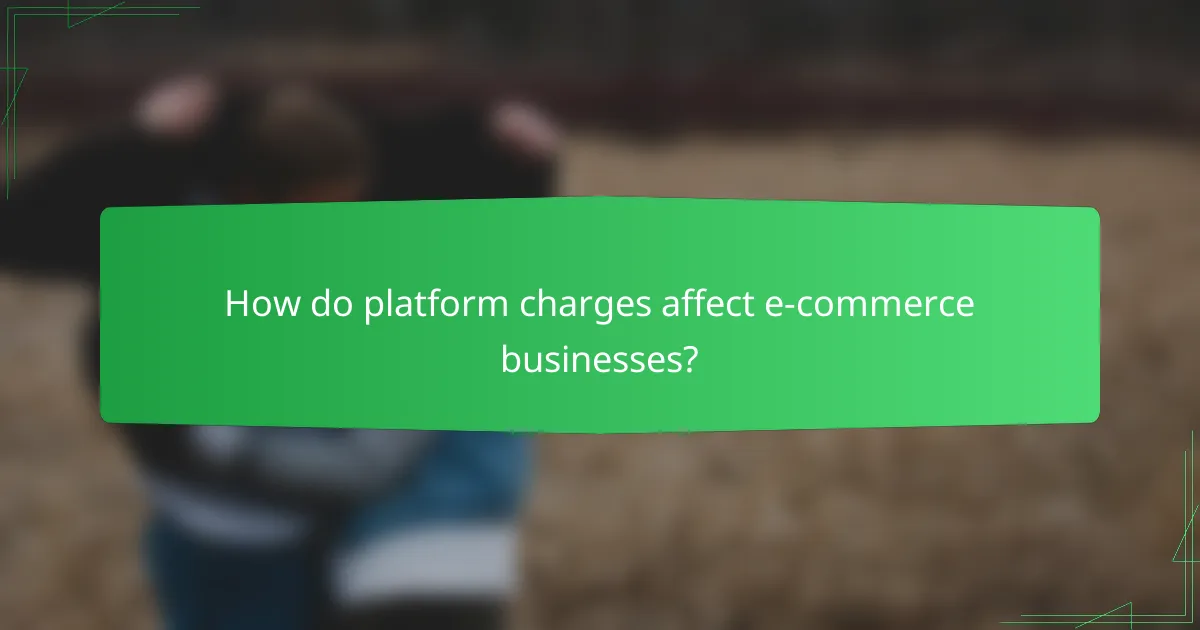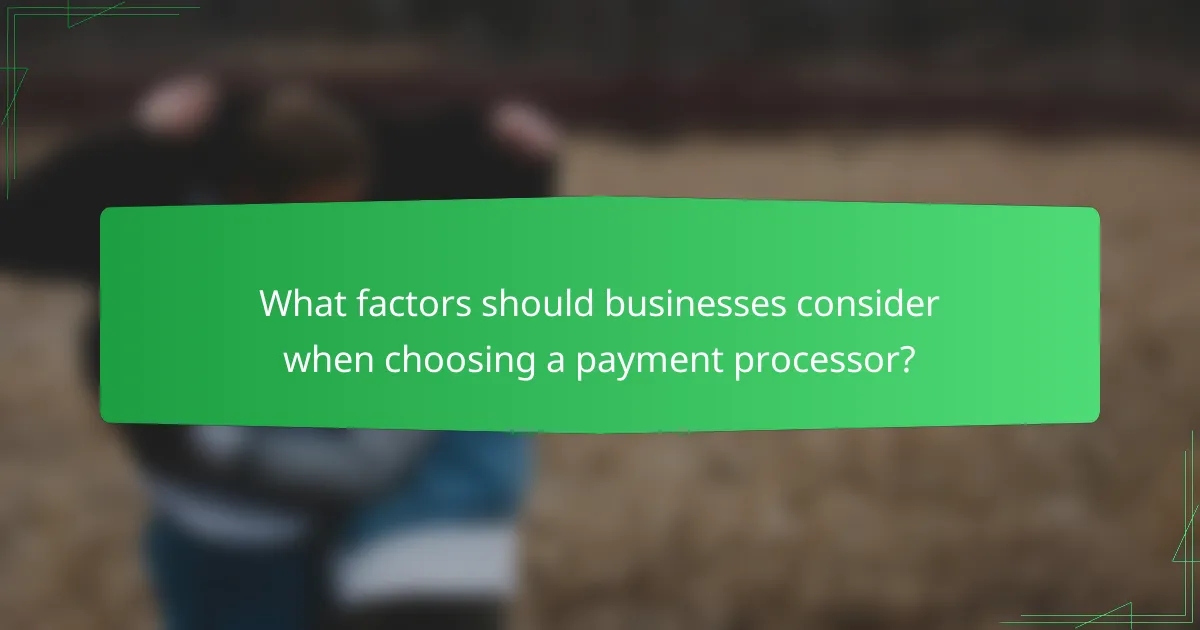E-commerce fees, including platform charges, transaction fees, and payment processing costs, play a significant role in the financial landscape of online businesses. Grasping these expenses is essential for effective management and profitability, as they can vary widely across different platforms. By understanding the structure of these fees, sellers can better strategize their pricing and budgeting to enhance their competitive edge.

What are the main e-commerce fees in the UK?
The main e-commerce fees in the UK include platform charges, transaction fees, and payment processing fees. Understanding these costs is crucial for managing your online business effectively and ensuring profitability.
Platform charges
Platform charges are fees that e-commerce platforms impose for hosting your online store. These can vary significantly based on the platform you choose, with some charging a monthly subscription fee while others may take a percentage of sales.
For example, platforms like Shopify or BigCommerce may charge between £25 to £300 per month depending on the features you need. Always review the pricing structure carefully to understand what is included and if there are any additional costs for apps or themes.
Transaction fees
Transaction fees are costs incurred each time a sale is made through your e-commerce platform. These fees can be a flat rate or a percentage of the sale, typically ranging from 1% to 5% depending on the platform and payment method used.
Some platforms, like Etsy, charge transaction fees on top of listing fees, while others may waive these fees for higher-tier subscription plans. Be sure to factor these fees into your pricing strategy to maintain profitability.
Payment processing fees
Payment processing fees are charged by payment gateways for handling transactions. In the UK, these fees usually range from 1.4% to 3.5% per transaction, plus a fixed fee per transaction, often around 20p.
Choosing the right payment processor can significantly impact your overall costs. Popular options like PayPal and Stripe offer competitive rates, but it’s essential to compare their fees and services to find the best fit for your business needs.

How do platform charges affect e-commerce businesses?
Platform charges significantly impact e-commerce businesses by affecting overall profitability and pricing strategies. These fees can vary widely depending on the platform, influencing how sellers manage their costs and pricing to remain competitive.
Monthly subscription costs
Many e-commerce platforms require monthly subscription fees that can range from low single digits to several hundred dollars. These costs typically cover access to the platform’s tools, hosting, and support services. Businesses should evaluate whether the features offered justify the subscription price based on their sales volume and operational needs.
For example, a small business might choose a basic plan at around $30 per month, while larger enterprises may opt for premium plans costing $300 or more. It’s crucial to assess the return on investment from these subscriptions.
Listing fees
Listing fees are charges that e-commerce platforms impose for each product listed on their site. These fees can be a flat rate per item or vary based on product category. Understanding these costs is essential for budgeting and pricing strategies.
For instance, a platform may charge $0.20 per listing, which can add up quickly for sellers with extensive inventories. It’s advisable to limit listings to high-demand products to maximize the return on listing fees.
Sales commissions
Sales commissions are fees taken from each sale made through the platform, often expressed as a percentage of the transaction amount. These commissions can range from around 5% to 20%, depending on the platform and the type of product sold.
Sellers should factor these commissions into their pricing models to ensure profitability. For example, if a platform charges a 10% commission and a seller prices a product at $50, they would need to account for a $5 fee, effectively reducing their revenue. Careful calculation of these fees is vital to maintaining healthy profit margins.

What are common transaction fees for e-commerce platforms?
Transaction fees for e-commerce platforms typically include a combination of percentage-based fees, flat-rate charges, and currency conversion fees. Understanding these fees is essential for budgeting and maximizing profits when selling online.
Percentage of sale
Percentage of sale fees are commonly charged by e-commerce platforms as a portion of each transaction. This fee usually ranges from around 2% to 5% of the total sale amount, depending on the platform and the seller’s sales volume. For example, if you sell an item for $100 and the fee is 3%, you would pay $3 to the platform.
When choosing an e-commerce platform, consider how these percentage fees impact your pricing strategy. Higher fees can significantly reduce your profit margins, especially for lower-priced items.
Flat-rate fees
Flat-rate fees are fixed charges that e-commerce platforms impose per transaction, regardless of the sale amount. These fees can vary widely, often ranging from $0.30 to $1.00 per transaction. For instance, if you sell multiple items at a low price, flat-rate fees can become a larger percentage of your total sales.
It’s important to evaluate how flat-rate fees fit into your overall cost structure. If your average sale price is low, a platform with lower flat-rate fees may be more cost-effective.
Currency conversion fees
Currency conversion fees apply when transactions involve different currencies, such as when a customer pays in euros while your account is in US dollars. These fees typically range from 1% to 3% of the transaction amount. This can add up, especially for international sales.
To minimize currency conversion fees, consider using a payment processor that offers competitive rates or allows you to hold multiple currencies. This can help you avoid unnecessary costs when selling to a global audience.

How do payment processing fees vary by provider?
Payment processing fees can differ significantly between providers, impacting your overall e-commerce costs. Typically, these fees include a percentage of the transaction amount plus a fixed fee per transaction, and they can vary based on factors like transaction volume and payment method.
PayPal fees
PayPal generally charges a fee of around 2.9% plus a fixed fee based on the currency for domestic transactions in the United States. For example, the fixed fee is $0.30 for USD transactions. International transactions may incur additional fees, which can increase the overall cost.
Merchants should consider PayPal’s fee structure when calculating their profit margins, especially for low-cost items. Additionally, PayPal offers discounted rates for businesses with higher sales volumes, which can be beneficial for larger e-commerce operations.
Stripe fees
Stripe’s standard fees are similar to PayPal’s, typically around 2.9% plus a fixed fee of $0.30 per successful transaction in the U.S. Stripe also supports a variety of payment methods, including credit cards and digital wallets, which can influence the fees charged.
One key advantage of Stripe is its transparent pricing and the ability to customize payment solutions. Businesses should evaluate whether Stripe’s features align with their needs, especially if they anticipate high transaction volumes or require advanced payment options.
Square fees
Square charges a flat rate of 2.6% plus $0.10 per transaction for in-person payments, while online transactions incur a fee of 2.9% plus $0.30. This straightforward pricing model makes it easy for businesses to estimate their costs.
Square also offers additional services, such as inventory management and customer engagement tools, which can add value for small businesses. However, merchants should be aware of potential fees for advanced features or integrations, which could affect overall expenses.

What factors should businesses consider when choosing a payment processor?
Businesses should consider fee structures, integration capabilities, and the overall user experience when selecting a payment processor. These factors can significantly impact profitability and customer satisfaction.
Fee structures
Understanding fee structures is crucial for businesses as they can vary widely among payment processors. Common fees include transaction fees, monthly fees, chargeback fees, and setup costs. For instance, transaction fees typically range from 1.5% to 3.5% of each sale, depending on the processor and the payment method used.
It’s essential to analyze both fixed and variable costs associated with each processor. Some may offer lower transaction fees but charge higher monthly fees, while others might have no monthly fees but higher per-transaction costs. Businesses should calculate their expected transaction volume to determine the most cost-effective option.
Integration capabilities
Integration capabilities refer to how easily a payment processor can connect with a business’s existing systems, such as e-commerce platforms or accounting software. A seamless integration can streamline operations and enhance the customer experience. Look for processors that support popular platforms like Shopify, WooCommerce, or Magento.
Additionally, consider whether the payment processor offers APIs or plugins that facilitate customization. A flexible integration can save time and reduce the need for extensive technical support. Businesses should also evaluate the level of customer support provided during the integration process to ensure a smooth transition.
